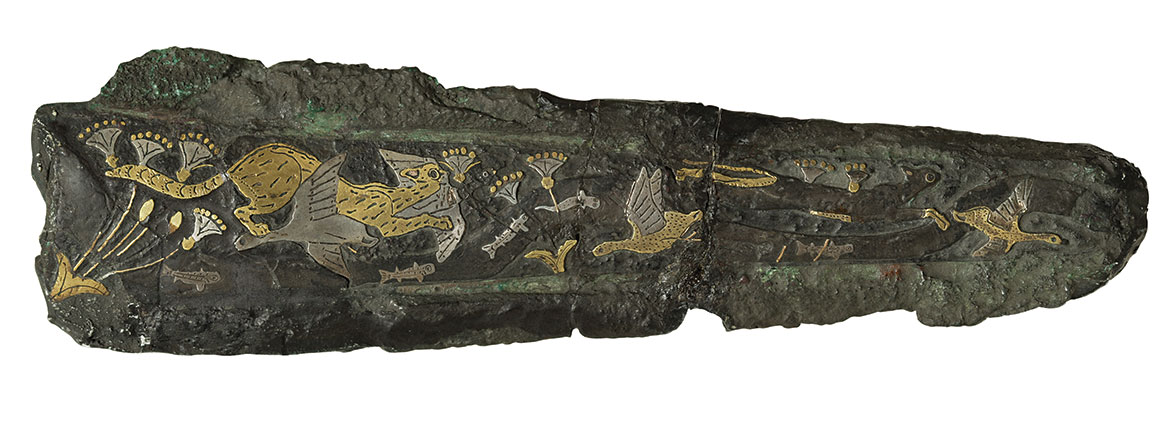Exhibit of the month
Once upon a time in the Aegean..
Bronze dagger with riverside landscape decoration
National Archaeological Museum, Collection of Mycenaean Antiquities, inv. no. P 765
Provenance: Mycenae, Grave Circle A, Tomb V
Dimensions: L. 16 cm., w. 4.7 cm.
Date: 16th c. BC
Exhibition Place: Room 4, Showcase 1
The luxurious bronze dagger found in the same burial assemblage as the famous ‘Agamemnon mask’, preserves the decorated blade intact, except for the tip where the -probably- gilded handle applied. The decoration, with inlaid silver and gold plates, renders with unique vitality one of the most beautiful narrative scenes in the iconography of the Mycenaean era: Wild cats attack ducks on the banks of a river covered in papyrus, while the dramatic moment is intensified by the image of the fish that flung themselves out of the water in disarray. The frightened birds flying in the opposite direction and the bodies of the animals entangled between the wings and clumps of papyri give the viewer the feeling of watching a ritual choreography.
The dagger belongs to a small group of luxury objects of the early Mycenaean era (16th-15th centuries BC) where subjects inspired by nature have been depicted, copying wall paintings of Thera and Minoan Crete. These scenes are conventionally known as “Nilotic landscapes” because they depict plants and animals endemic to Egypt. However, apart from the fact that they pre-date the corresponding Egyptian representations, in recent years the scientific evidence that identifies them with the Aegean landscape has also increased, highlighting at the same time the great climatic and geomorphological changes that took place over the centuries.
The findings of a recent archaeobotanical research on the climate and landscape of Thera before the eruption of the volcano, in the 16th century. BC, indicate that representations of this kind give real evidence of the flora and fauna of the island: a large part was covered by streams hidden in reeds, with waterfowl and fish, while wild cats seem to have been brought there, as in Crete, from a very early age, possibly in order to control rodent populations.
Eleni Konstantinidi-Syvridi
Bibliography:
Boss, M., – Laffineur, R., 1997. Mycenaean Metal Inlay: A Technique in Context, in R. Laffineur – P. Betancourt (ed.),TEXNH. Craftsmen, Craftswomen and Craftsmanship in the Aegean Bronze Age. Proceedings of the 6thInternational Aegean Conference, Philadelphia, Temple University, 18-21 April 1996, Aegaeum 16, Liège: 191-197.
Papayanni, K., Pomadere, M., 2020. The Cat: an Exotic Animal in the Minoan World? in B. Davis – R. Laffineur (ed.), Younger: Studies in Bronze Age Aegean art and archeology in honor of Professor John G. Younger on the occasion of his retirement, Aegaeum 44,Liège: 237-250.
Phillips, J., 1995. False analogies: the Minoan origin of some so-called ‘Egyptianizing’ features, in NE Papadogiannakis (ed.), Proceedings of the Z’ International Christological Conference, A2, Rethymnon: Holy Metropolis of Rethymnon and Avlopotamos: 757 -65.
Vlachopoulos, A., Zorzos, L., 2014. Physis and Techne on Thera: Reconstructing Bronze Age Environment and Land-Use Based on New Evidence from Phytoliths and the Akrotiri Wall-Paintings, in G. Touchais, R. Laffineur, F. Rougemont (ed.), PHYSIS. L’ENVIRONNEMENT NATUREL ET LA RELATION HOMME-MILIEU DANS LE MONDE ÉGÉEN PROTOHISTORIQUE, Actes de la 14e Rencontre égéenne internationale, Paris, Institut National d’Histoire de l’Art (INHA), 11-14 décembre 2012, Aegaeum 37, Leuven- Liege: 183-197.


